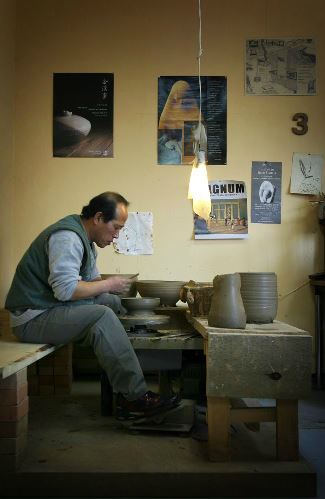The world of ceramics for an artist with a modeling spirit of earth, water, and fire.
Ceramics is a genre of the oldest history amongst various styles of art. It possesses the unique quality of the materials utilized constituting of the overall basic elements of space. Ceramics – formed through the use of the basics of life, earth, water, and fire. Having never changed its materials back from when art had emerged, up to this very day, and having never left the side of human beings. This was art before art existed.
People who work with earth are generally naive and genial. This also held true for potter Hansa Kim. His studio set up in Ahn Sung in Kyung Ki Do was a magnificent place where his old dreams came true, surrounded by nature, and his good-natured appearance, with his earthy overalls and his hat was that of a person who, through years of spinning wheel work, figured out every element of earth, hence able to secretly communicate with the sound of the earth.
Moreover, his work was a world made from the beauty of cloths, created from primitive briefness, modular transfiguration, and the movements of an exciting tune. It was a mythical world of which only a person with the somewhat trait of water, a person who can freely travel through the world of flow, which can be called the beauty of emptiness. On the other hand, the person withholding natural naivety as soft as earth, a world as calm as water, and the power fire to restore new creations, was Hansa Kim. As the owner of an artistic creative mind of the materials of ceramics, earth, water, and fire, his pieces always possess a holy charm, which draws our attention.
His celadon pieces, which hold their objective in the reinterpretation of tradition and modern transformation, have already received great reaction and praises at the Japanese Fukuoka art gallery, the Italian Milano Palazzo Isimbardi, and the Canadian Craft museum. I figure that the background behind this result was the materialistic primitiveness of the celadon, as well as the vigilant craftsmanship of the artist (I want to call this the ‘kiln-ship’ of the artist), and the creative expression, which befits the modern aesthetic form.
Deformed and rich, the surface of the celadon gains the gaining of not aiming for amusing pleasure through the childlike expression. It is certain that this is a mentally and emotionally spectacular work, possessing the characteristic strength of Korea. This is why it touches our emotions and pleasures our eyes upon viewing the pieces. Thus, the coexistence of inner and outer verse draws the beauty of modern ceramics of the celadon. It is said that when repeating a hobby, it becomes a skill, when repeating a skill, it becomes karma, and when repeating karma, it becomes a craft.
Yangdong Kim, Dean of Kye Myung University

